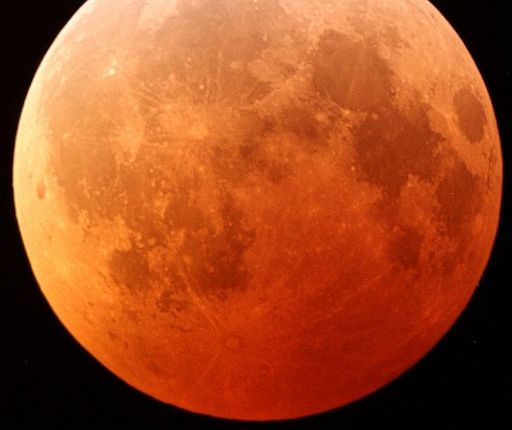
2014 SPACEWEATHER PAGES
JANUARY -
FEBRUARY, MARCH,
APRIL,
MAY,
JUNE,
JULY, AUGUST,
SEPTEMBER, OCTOBER, NOVEMBER,
DECEMBER

BLOOD ECLIPSE FROM 2010
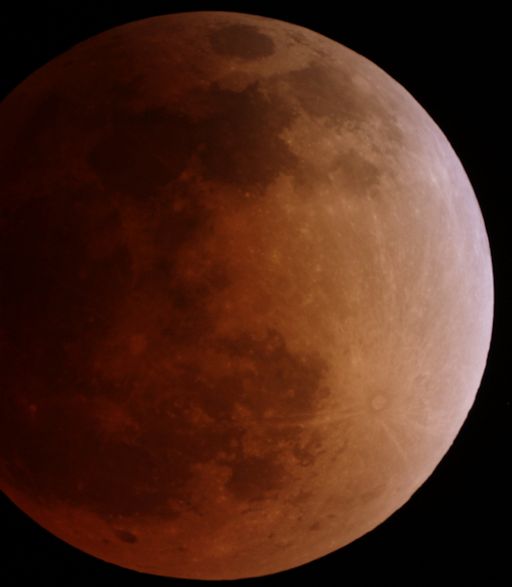
RED ECLIPSE 2014
Dee Finney's blog
start date July 20, 2011
today's date April 1, 2014
updated daily
page 660
TOPIC: SPACEWEATHER - APRIL 2014
4-30-14
Solar wind
speed: 311.6 km/sec
density: 3.3 protons/cm3
AUSTRALIAN SOLAR ECLIPSE: Today
when the sun set over Australia, sky watchers noticed something odd--a piece of
the sun was missing. The new Moon passed in front of the sun producing a partial
eclipse as deep as 70%. This was the view from Adelaide, South Australia:
"Here the eclipse peaked at 51% and was still in progress as the sun was setting," says photographer Martin Lewicki. "We could see it clearly through the clouds."
Visibility of this eclipse was restricted to Australia and the coast of Antarctica: map. While Australians witnessed a partial eclipse, in Antarctica the Moon passed directly in front of the sun, producing a "ring of fire" annular eclipse. Photographs of that phase, however, might not be forthcoming because of the remote location. Browsethe eclipse gallery for updates:
CME NARROWLY MISSES EARTH https://www.youtube.com/watch?v=7ukQhycKOFw
7 FIREBALLS REPORTED
4-29-14
Solar wind
speed: 306.1 km/sec
density: 2.0 protons/cm3
explanation | more
data
Updated: Today at 2345 UT
7 FIREBALLS REPORTED
4-28-14
Solar wind
speed: 295.8 km/sec
density: 1.9 protons/cm3
CONTINUED QUIET: Solar activity remains low. Only a few sunspots are facing Earth, and none has the kind of complex magnetic field that harbors energy for strong explosions. NOAA forecasters estimate a 10% chance of M-class flares and only a 1% chance of X-flares on April 28th
MYSTERIOUS SUN PILLAR ECHOS: Many of us have witnessed sun pillars--columns of light that lance upwards from the horizon just as the sun is rising or setting. They are caused by plate-shaped ice crystals in clouds that bend the rays of the low-hanging sun. While sun pillars are frequently seen, in all seasons and at all latitudes, elusive companions of sun pillars may have been frequently overlooked. They are called sun pillar "echos":
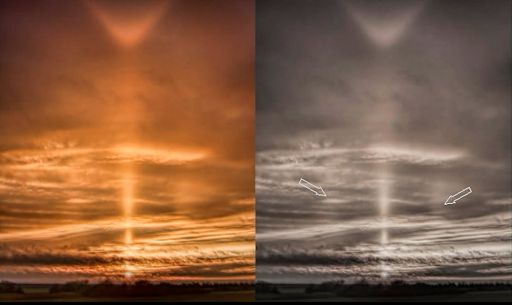
Image credit: Jon Inghram. Larger images: #1, #2
Atmospheric optics expert Les Cowley explains: "13 years ago in Finland, three halo experts saw peculiar 'echoes' straddling an otherwise ordinary sun pillar. They could not be explained and there the matter rested for want of confirmation by another observation. Then, last week, Jon Inghram sent me several sun pillar images. He too had noticed faint 'echoes' on each side of his pillar – the mysterious ice halo was at last confirmed!"
"More details and pictures may be found in an article here. But we still cannot explain them. The Finland observers, Jon and I have each tried simulations using the flattened pyramid crystals invoked to account for elliptical halos. They do not work at all well. We need many more observations! Take plenty of pictures of each pillar. The echoes are easily overlooked or mistaken for cloud patches and have probably been seen many times. Observations under different conditions could help unravel their mystery."
7 FIREBALLS REPORTED
4-27-14
Solar wind
speed: 321.2 km/sec
density: 1.9 protons/cm3
QUIET SUN: Solar activity is low. Only a few sunspots are facing Earth, and none has the kind of complex magnetic field that harbors energy for strong explosions. NOAA forecasters estimate a waning 10% chance of M-class flares and only a 1% chance of X-flares on April 27th.
RADIO BLACKOUT: An X-class solar flare on April 25th irradiated Earth's upper atmosphere with extreme ultraviolet radiation. Waves of ionization rippled around the dayside of the planet, causing a widespread blackout of shortwave radio transmissions. Radio astronomer Dick Flagg recorded the event at his observatory at the Windward Community College on Oahu:
"This is a dynamic spectrum," explains Flagg. "The vertical axis is frequency (MHz) and the horizontal axis is time (UTC)." All of the horizontal lines corresponding to terrestrial radio stations vanished in the aftermath of the flare.
The active region responsible for the flare rotated off the solar disk yesterday, so even if it flares again, another radio blackout is unlikely this weekend. NOAA forecasters estimate the odds of an X-flare on April 27th to be a scant 1%
DOOMED MOON OF MARS: Mars has two small moons: Phobos and Deimos. One of them is doomed. Phobos orbits so close to Mars - about 5,800 kilometers above the surface compared to 400,000 kilometers for our own Moon - that gravitational tidal forces are dragging it down. In 100 million years or so Phobos will likely be shattered by tidal shear, the debris forming a decaying ring around Mars.
With the countdown clock clicking, astrophotographer Peter Rosén was determined to photograph the diminutive moon, and on April 24th he succeeded:
"My previous attempt at photographing Phobos and Deimos resulted in Deimos
alone, so I tried again last night, slightly changing my setup," says Rosén.
"This time I managed to get the even more elusive Phobos at mag. 11.8 ,
separated only by 11 arcseconds from the blindingly bright Mars at mag. -1.28."
"I inserted the orbital path of both moons to show how much closer Phobos is to
the planet compared to Deimos and also that Phobos is on track."
"So why doesn't Deimos show in this 2-frame
animation?," he asks. "It was positioned below the planet at a separation of
15 arcseconds at that time and being a full magnitude dimmer (almost 13) it was
just invisible."
9 FIREBALLS REPORTED
4-26-14
Solar wind
speed: 394.6 km/sec
density: 2.1 protons/cm3
X-FLARE: On April 25th, an active region near the sun's western limb erupted, producing an impulsive X-class solar flare. A pulse of extreme UV radiation from the flare ionized Earth's upper atmosphere and caused a shortwave radio blackout on the dayside of Earth. However, a CME hurled into space by the explosion will miss our planet.
The explosion also produced a CME, but because the blast site was so close to the sun's western limb, the cloud is not heading toward our planet. A movie of the CME from the Solar and Heliospheric Observatory shows the CME apparently hitting Mercury, but looks can be deceiving:
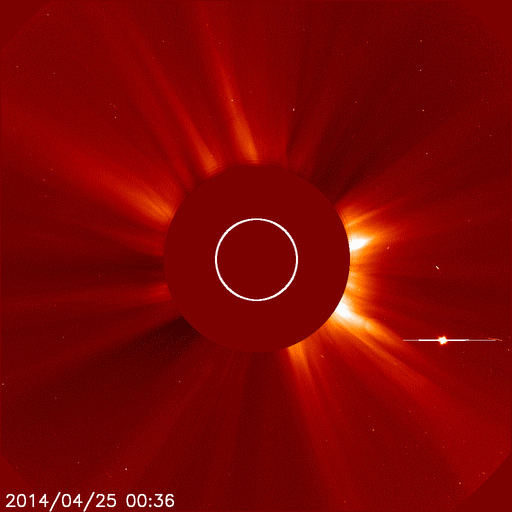
CME - SUN - MERCURY
FEAR AND DREAD: The moons of Mars are so small, some astronomers believe they are captured asteroids. Named Phobos and Deimos (Fear and Dread), the dimunutive satellites average 17 km in diameter and are rarely seen in pictures of Mars. On April 20th, astrophotographer Peter Rosén attempted to capture both.
"I knew from many unsuccessful attempts in the past that photographing Phobos and Deimos is not an easy task due to the glare from Mars," says Rosén. "I rotated my 10-inch Newtonian telescope so the moons would not be positioned in the cross of light from the spider vanes. Phobos could not be identified as it was inside the overexposed area, but Deimos was clearly shown on 2 of the exposures. This two-frame animation shows Deimos in orbit. Fortunately Deimos is staying on track :-) I also captured an image of Mars at the beginning of the session and inserted it as a reference of size and orientation."
Realtime Mars Photo Gallery
19 fireballs reported
4-25-14
Solar wind
speed: 390.5 km/sec
density: 2.2 protons/cm3
4-24-14
Solar wind
speed: 478.4 km/sec
density: 2.4 protons/cm3
20 fireballs reported
4-23-14
Solar wind
speed: 410.6 km/sec
density: 2.8 protons/cm3
LYRID METEOR SHOWER: The annual Lyrid meteor shower, caused by debris from ancient Comet Thatcher, is subsiding. During the shower's peak on April 22nd, dark-sky observers saw as many as 15 meteors per hour. Check the meteor gallery for sightings.
CHANCE OF STORMS: NOAA forecasters estimate a 30% chance of polar geomagnetic storms on April 23-24 when the interplanetary magnetic field (IMF) is expected tip south, opening a crack in Earth's magnetosphere. Solar wind pouring in could ignite auroras,
20 fireballs reported
4-22-14
Solar wind
speed: 442.5 km/sec
density: 1.3 protons/cm3
SUBSIDING CHANCE OF STORMS: NOAA forecasters have downgraded the chance of geomagnetic storms today to 35% as Earth exits a stream of high-speed solar wind. High-latitude sky watchers should be alert for fading auroras
LYRID METEOR SHOWER: Earth is passing through a stream of debris from ancient Comet Thatcher, source of the annual Lyrid meteor shower. Last night, NASA's All-Sky Fireball Network detected a bright Lyrid flying over Allegheny, Pennsylvania:
Usually the Lyrid meteor shower is mild (10-20 meteors per hour), but unmapped filaments of dust in the comet's tail sometimes trigger outbursts ten times stronger. So far this year's shower is trending toward the usual--that is, mild--but surprises are possible. Forecasters espect the shower to peak on April 22nd between the hours of 10:00 UT and 21:00 UT. Got clouds? Listen for Lyrid radar echoes onSpace Weather Radio.
15 fireballs reported
4-21-14
Solar wind
speed: 513.5 km/sec
density: 1.3 protons/cm3
GEOMAGNETIC UNREST: As predicted, a CME struck Earth's magnetic field on Easter Sundy. Gusty solar wind conditions in the CME's wake are sparking auroras around the Arctic Circle. Last night, Northern Lights descended as far south as Isabel, South Dakota:
The aurora grew and sent pulsing pillars across the northern sky above Isabel Lake," says photographer Christian Begeman. "The show only lasted about 10 to 15 minutes. Just 45 minutes later, there was only a faint coloring in the sky."
Meanwhile in the southern hemisphere, the aurora australis reached as far north as Yallingup, Australia. "It was amazing to witness such a rare display from Western Australia!" says photographer Steve Brooks.
NOAA forecasters estimate a 60% chance of geomagnetic activity on April 21st as the solar wind continues to blow. High-latitude sky watchers should remain alert for auroras Aurora alerts: text, voice
9 fireballs reported
4-20-14
Solar wind
speed: 716.8 km/sec
density: 5.4 protons/cm3
INCOMING STORM CLOUDS: Three or four CMEs that left the sun earlier this week will arrive in quick succession this weekend. Mostly, the blows they deliver to Earth's magnetic field are expected to be weak, but the combined impacts could stir up significant geomagnetic activity. NOAA forecasters put the odds of a high-latitude geomagnetic storm at 55% on Saturday, increasing to 75% on Sunday. Check http://spaceweather.com for updates.
GEOMAGNETIC STORM IN PROGRESS, MORE TO COME: A minor G1-class geomagnetic storm is in progress following a CME strike during the early hours of April 20th.
LYRID METEOR SHOWER: Earth is approaching a stream of debris from ancient Comet Thatcher, source of the annual Lyrid Meteor Shower. Usually the shower is mild (10-20 meteors per hour) but unmapped filaments of dust in the comet's tail sometimes trigger outbursts ten times stronger. Forecasters expect this year's peak, however strong it may be, to occur on April 22nd. [meteor gallery]
4-19-14
Solar wind
speed: 540.6 km/sec
density: 4.0 protons/cm3
M CLASS FLARE ON THE WAY
M7-CLASS SOLAR FLARE (UPDATED): Sunspot AR2036 erupted on April 18th at 1307 UT, producing a strong M7-class solar flare. NASA's Solar Dynamics Observatory recorded the extreme ultraviolet flash:
An S1-class radiation storm is underway in the aftermath of the flare. However, this is a relatively minor storm which poses minimal threat to satellites and aircraft.
Of greater interest is a CME that emerged from the blast site. The Solar and Heliospheric Observatory recorded the storm cloud racing away from the sun at aproximately 800 km/s:
This CME could deliver a glancing blow to Earth's magnetic field on April 20-21. Two or three minor CMEs traveling ahead of this one are expected to arrive on April 19-20, and the combined impacts could generate geomagnetic activity throughout the weekend. NOAA forecasters put the odds of a geomagnetic storm at 55% on Saturday, increasing to 75% on Sunday. High-latitude sky watchers should be alert for auroras. Solar flare alerts: text, voice
6 FIREBALLS REPORTED
4-18-14
Solar wind
speed: 489.0 km/sec
density: 3.5 protons/cm3
THE TURQUOISE FRINGE: Lunar eclipses are supposed to be red, yet when the Moon passed through Earth's amber shadow on April 15th, many observers witnessed a softly-glowing band of turquoise blue. Robert and Elisabeth Slobins send this picture of the phenomenon from Fort Myers, Florida:
The source of the turquoise is ozone. Prof. Richard Keen, an atmospheric scientist from the University of Colorado explains: "During a lunar eclipse, most of the light illuminating the Moon passes through the stratosphere, and is reddened by scattering. However, light passing through the upper stratosphere penetrates the ozone layer, which absorbs red light and actually makes the passing light ray bluer!" This can be seen, he says, as a turquoise fringe around the red.
For years, Keen has been using lunar eclipses to probe the transparency of the stratosphere. When the stratosphere is clogged with volcanic ash and other aerosols, lunar eclipses tend to be dark red. The bright orange color of the April 15th eclipse, along with the ready visibility of the turquoise fringe, suggests that the stratosphere is clear. This is a key finding for climate change models.
To see the effects of ozone on the eclipse, you have to be looking at just the right moment. Readers are invited to browse the gallery for more examples:
Realtime Eclipse Photo Gallery
6 fireballs reported
4-17-14
Solar wind
speed: 379.3 km/sec
density: 7.0 protons/cm3
EARTH-SIZED PLANET IN THE HABITABLE ZONE OF ANOTHER STAR: Using NASA's Kepler Space Telescope, astronomers have discovered the first Earth-size planet orbiting in the "habitable zone" of another star. The planet, named "Kepler-186f" orbits an M dwarf, or red dwarf, a class of stars that makes up 70 percent of the stars in the Milky Way: full story.
WATCH THE MOVIE OF AN M7 CLASS FLARE
Watch the movie again. A dark plume of plasma leaps out of the blast site, and some it it left the sun in the form of a faint, Earth-directed CME. NOAA forecasters expect the storm cloud to reach Earth on April 19th around 1800 UT, possibly sparking geomagnetic storms. High-latitude sky watchers should be alert for auroras. Solar flare alerts: text, voice
13 FIREBALLS REPORTED
4-16-14
Solar wind
speed: 342.0 km/sec
density: 16.3 protons/cm3
FOUR SUNSPOTS COULD FLARE - MOVIE AND PHOTO ABOVE
13 fireballs reported
4-15-14 FUL LUNAR ECLIPSE - FIRST OF FOUR BLOOD MOONS
http://www.greatdreams.com/blog-2013-3/dee-blog577.html
WE WERE VERY DISAPPOINTED WITH THE LOOKS OF THIS RED MOON. THE SKY HAD A FILMY FOG IN IT WAY UP HIGH, AND WE COULD SEE A GREEN RING AROUND THE MOON AT A GREAT DISTANCE - PERHAPS THE REFLECTION OF THE MOON, BUT THE QUESTION WAS, WHAT WOULD CAUSE THE RING TO TURN GREEN?
I SPOKE TO A WOMAN WHO LIVED IN THE OUTSKIRTS OF LAS VEGAS, NV, AND SHE SAID HER EXPERIENCE WITH LOOKING AT THE MOON WAS EXACTLY THE SAME?
SINCE THE DISTANCE WAS QUITE GREAT BETWEEN WHERE SHE LIVED AND WHERE I LIVED, WHY WOULD HER SKY AND THE LOOKS OF THE MOON BE THE SAME - BLURRY LIKE FOG WAS HANGING IN THE AIR?
4-14-14 FULL LUNAR ECLIPSE - FIRST OF FOUR BLOOD MOONS
TOTAL LUNAR ECLIPSE: Mark your calendar. On April 15th, there will be a total eclipse of the Moon visible from Australia, New Zealand, and all of the Americas. The action begins on Tuesday at 2 AM Eastern time. Get the full story and a video from Science@NASA.
4-13-14
Solar wind
speed: 379.5 km/sec
density: 2.9 protons/cm3
MOSTLY QUIET WITH A CHANCE OF FLARES: With no sunspots actively flaring, solar activity is low. However, the quiet might be short-lived. Active regions AR20032 and AR2035 have 'beta-gamma' magnetic fields that harbor energy for M-class solar flares. NOAA forecasters estimate a 35% chance of such an eruption during the next 24 hours.
LUNAR ECLIPSE, TUESDAY MORNING: The mainstream media is abuzz with reports of a "blood moon" on Tuesday morning. The scientific term is "lunar eclipse." On April 15th at 6 minutes past midnight Pacific Time (3:06 a.m Eastern Time), the Moon will enter the sunset-colored colored shadow of Earth, producing a total eclipse of the Moon:
The color of Earth's shadow, and thus the color of the eclipsed Moon, depends substantially on the amount of volcanic ash and other aerosols floating in the stratosphere. According to atmospheric sciences professor Richard Keen of the University of Colorado, the stratosphere is clear. This means the eclipse will be not "blood red," but rather bright orange.
See for yourself. The event will be visible from Australia, New Zealand, and all of the Americas: visibility map. It's so bright, even observers in light-polluted cities will have no trouble enjoying the show. Got clouds? No problem. The event will be broadcastlive on the web by the Coca-Cola Science Center at Columbus State University in Georgia.
For more information about the eclipse, get the full story and a video from Science@NASA.
Realtime Space Weather Photo Gallery
NASA SPACECRAFT vs. THE LUNAR ECLIPSE: NASA's LADEE spacecraft, now orbiting the Moon on a mission to study the lunar atmosphere, might not survive the lunar eclipse. "LADEE wasn't designed to go through a long eclipse and keep things running," says Richard Elphic, the project scientist for LADEE at NASA Ames.
The spacecraft is solar powered, and it uses battery-driven heaters to keep itself warm. LADEE regularly experiences periods of low-to-no sunlight for 45 minutes when it passes over the nightside of the Moon. During the eclipse, the "shadow time" will last as much as 4 hours.
"Even dipping into the penumbra (the outskirts of Earth's shadow) means we lose power generation, and for the full Earth umbra (the dark core of Earth's shadow) there's no solar array generation at all," continues Elphic. "So we'll be running on battery, with no array generation, and using heaters more than usual to keep things warm."
"There are some areas of the spacecraft that will not be warmed up by heaters – part of LADEE's propulsion system, for example. So it is possible these might freeze and never warm up sufficiently again. We won't know until after eclipse and we get housekeeping and state of health data," says Elphic.
And now for the good news. "Our in flight data show that power and thermal are behaving better than predicted, because of the built in margins, so we expect the spacecraft to survive just fine," reports Butler Hine, the LADEE Project Manager at Ames. "The unheated portions of the propulsion system are mainly what we will be watching for any freezing."
Regardless of how LADEE emerges from the eclipse, the mission is near its end. NASA's plans to crash LADEE into the lunar surface as part of a "skimming" maneuver that will allow the spacecraft to sample the Moon's near-surface atmosphere. "We have already used our extra fuel for the one month extension we are in now," concludes Hine. "Even if we survive the eclipse we will impact as planned. We do get an extra week of science data if we survive the eclipse, however."
Stay tuned for updates from LADEE.
CAPE CANAVERAL, Fla. (AP) -- NASA's robotic moon explorer, LADEE, is no more.
Flight controllers confirmed Friday that the orbiting spacecraft crashed into the back side of the moon as planned, just three days after surviving a full lunar eclipse, something it was never designed to do.
Researchers believe LADEE likely vaporized when it hit because of its extreme orbiting speed of 3,600 mph, possibly smacking into a mountain or side of a crater. No debris would have been left behind.
"It's bound to make a dent," project scientist Rick Elphic predicted Thursday.
By Thursday evening, the spacecraft had been skimming the lunar surface at an incredibly low altitude of 300 feet. Its orbit had been lowered on purpose last week to ensure a crash by Monday following an extraordinarily successful science mission.
LADEE - short for Lunar Atmosphere and Dust Environment Explorer - was launched in September from Virginia. From the outset, NASA planned to crash the spacecraft into the back side of the moon, far from the Apollo artifacts left behind during the moonwalking days of 1969 to 1972.
It completed its primary 100-day science mission last month and was on overtime. The extension had LADEE flying during Tuesday morning's lunar eclipse; its instruments were not designed to endure such prolonged darkness and cold.
But the small spacecraft survived - it's about the size of a vending machine - with just a couple pressure sensors acting up.
The mood in the control center at NASA's Ames Research Center in Mountain View, Calif., was upbeat late Thursday afternoon, according to project manager Butler Hine.
"Having flown through the eclipse and survived, the team is actually feeling very good," Hine told The Associated Press in a phone interview.
But the uncertainty of the timing of LADEE's demise had the flight controllers "on edge," he said.
As it turns out, LADEE succumbed within several hours of Hine's comments. NASA announced its end early Friday morning.
It will be at least a day or two before NASA knows precisely where the spacecraft ended up; the data cutoff indicates it smashed into the far side of the moon, although just barely.
LADEE did not have enough fuel to remain in lunar orbit much beyond the end of its mission. It joined dozens if not scores of science satellites and Apollo program spacecraft parts that have slammed into the moon's surface, on purpose, over the decades, officials said. Until LADEE, the most recent man-made impact was the LCROSS crater-observing satellite that went down in 2009.
During its $280 million mission, LADEE identified various components of the thin lunar atmosphere - neon, magnesium and titanium, among others - and studied the dusty veil surrounding the moon, created by all the surface particles kicked up by impacting micrometeorites.
"LADEE's science cup really overfloweth," Elphic said earlier this month. "LADEE, by going to the moon, has actually allowed us to visit other worlds with similar tenuous atmospheres and dusty environments."
---
10 FIREBALLS REPORTED
4-12-14
Solar wind
speed: 327.0 km/sec
density: 7.3 protons/cm3
SUBSIDING STORM: A polar geomagnetic storm that began during the late hours of April 11th is subsiding now. At its peak, the storm registered 5 on the Kp scale of magnetic disturbances, which means it was a relatively minor event. Nevertheless, it was strong enough to spark naked-eye auroras.
The storm began on April 11th when the interplanetary magnetic field (IMF) near Earth tipped south, opening a crack in our planet's magnetosphere. Solar wind poured in to fuel the display. Although the storm is subsiding, more auroras are possible on April 12th. NOAA forecasters estimate a 40% chance of renewed geomagnetic storming during the next 24 hours
10 fireballs reported
4-11-14
4-10-14
4-9-14
4-8-14
Solar wind
speed: 378.2 km/sec
density: 2.7 protons/cm3
QUIET SUN: With no sunspots actively flaring, solar activity is low. NOAA forecasters put the odds of an X-flare today at no more than 1%.
CLOSE ENCOUNTER WITH MARS: This is a good week to see the planet Mars. On April 8th, Mars will be "at opposition"--that is, perfectly opposite the sun in the midnight sky. And then, on April 14th, Mars makes its closest approach to Earth since 2012. Look for the Red Planet rising in the east at sunset, shining brighter than a 1st-magntitude star.
"The reddish tint of Mars contrasts nicely with blue-white Spica, the brightest star in Virgo," says Dyer. "If the arrangement of Mars and Spica looks unusual, it's because I took this from Australia. So the relative position of Mars and Spica looks upside down compared to a northern hemisphere view. The gum trees in the foreground are illuminated by the waxing Moon."
To learn more about the close encounter, watch the video "Opposition of Mars" from Science@NASA.
3 fireballs reported
4-7-14
Solar wind
speed: 353.6 km/sec
density: 7.2 protons/cm3
SPACE STATION SIGHTINGS: This week, the International Space Station is making a series of bright passes over towns and cities in North America. On April 5th in Albany, Missouri, Dan Bush witnessed an ISS-lunar conjunction:
"The moon was surrounded by a beautiful ice halo when the space station passed by," says Bush. "This is a composite of eight 20-second exposures."
Soon, the streak the ISS makes when it passes overhead will double. On Monday, April 14th, SpaceX will launch a Dragon spacecraft to rendezvous with the space station. Filled with almost 5,000 pounds of scientific experiments and supplies, the Dragon will dock with the ISS two days later on April 16th. Prior to docking, sky watchers might be able to see the two spacecraft, ISS and Dragon, moving in tandem through the night sky.
Dragon will remain attached to the space station's Harmony module until mid-May and splash down in the Pacific Ocean off the coast of Baja California with more than 3,000 pounds of experiment samples and equipment returning from the station.
To find out when the ISS and, soon, the Dragon will fly over your hometown, check Spaceweather.com's Simple Satellte Tracker.
4 fireballs reported
4-6-14
Solar wind
speed: 398.9 km/sec
density: 6.3 protons/cm3
3 fireballs reported
4-5-14
Solar wind
speed: 450.6 km/sec
density: 37.3 protons/cm3
WEAK IMPACT: Solar wind signatures suggest that a CME delivered a glancing blow to Earth's magnetic field during the early hours of April 5th. The weak impactdid not spark a geomagnetic storm. Nevertheless, high-latitude auroras are possible as Earth passes through the wake of the CME
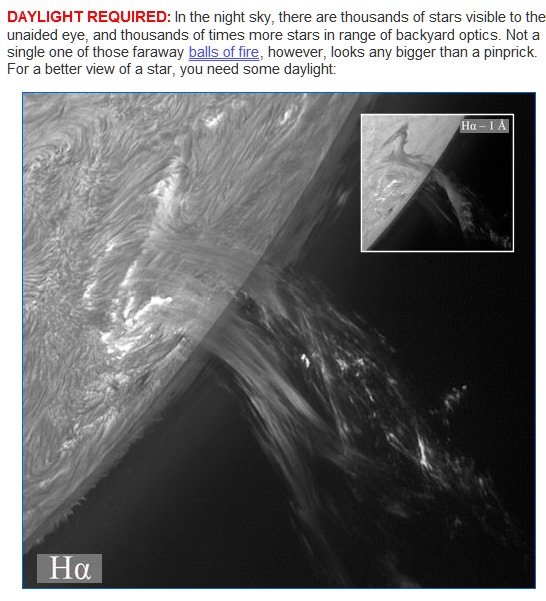
This star is the sun. Francois Rouviere of Mougins, France, took the picture on March 31st using no more than a 7-inch refracting telescope and an "H-alpha" filter tuned to the red glow of solar hydrogen.
"I caught this impressive explosion at the sun's western limb near sunspot AR2014," says Rouviere. "The inset, which is at a wavelength 1 Å shorter than H-alpha, shows fast moving material blue-shifted by the Doppler effect."
Got a solar telescope? NOAA forecasters estimate a 40% chance of M-class flares and a 5% chance of X-flares on April 4th. Train those optics on the daylight sky.Solar flare alerts: text, voice
Note: Always use safe solar filters when observing the sun. Unfiltered sunlight, focused by optics, can cause serious eye damage.
3 fireballs reported
4-4-14
Solar wind
speed: 420.6 km/sec
density: 1.9 protons/cm3
INCOMING CMEs: A pair of CMEs that left the sun on April 1st and 2nd have probably merged and will deliver a combined glancing blow to Earth's magnetic field late on April 4th. NOAA forecasters estimate a 50% chance of geomagnetic storms in reponse to the impact. High-latitude sky watchers should Aurora alerts: text,voice
THREE EXPLOSIONS: Yesterday, during the late hours of April 3rd, three active regions on the sun exploded in quick succession. Play the movie, then consider the question: Was that three explosions, or just one? (continued below)
Visually, the rapid-fire explosions appear to be causally linked, and indeed they might have been. Since 2010, when SDO was launched, solar physicists have increasingly appreciated the interconnectedness of explosions on the sun. SDO's full-disk view has shown that magnetic instabilities can hop from one sunspot to another, propagating hundreds of thousands of kilometers to cause chain reactions on a titanic scale. The Global Eruption of August 2010 is the iconic example.
When eruptions are as big as this, it's hard for Earth to stay out of the line of fire.Watch the movie again. Material hurled away from the rightmost blast site could form the basis of a CME that reaches Earth in a few days. Stay tuned for updates about this possibility. Solar flare alerts: text, voice
9 fireballs reported
4-3-14
Solar wind
speed: 391.1 km/sec
density: 4.2 protons/cm3
CMEs MISS EARTH: NOAA forecasters have downgraded the chance of geomagnetic storms on April 3rd to only 1%. This follows a storm warning on April 2nd when a group of CMEs were expected to sideswipe Earth's magnetic field. However, all of the CMEs appear to have missed our planet. Aurora alerts: text,voice
M6-CLASS SOLAR FLARE: Northern sunspot AR2027 erupted on April 2nd at 14:05 UT, producing a significant M6-class solar flare. NASA's Solar Dynamics Observatory recorded the extreme ultraviolet blast:
In the movie, you can see material being hurled into space. That is the genesis of a spectacular CME now racing away from the sun's eastern limb. Our planet was not in the line of fire, but the expanding cloud might nevertheless have an Earth-directed component. Stay tuned for updates. Aurora alerts: text, voice
APPROACHING MARS: In the next 60 seconds you will be 300 km closer to the planet Mars. As April begins, Earth and Mars are converging at 5 km/s or 300 km/min for a close approach two weeks from now. This matrix of images, taken by Puerto Rican photographer Efrain Morales Rivera, shows how the Red Planet has grown in the eyepiece of his 12-inch telescope over the past month:
Even the smallest of Rivera's images shows the martian North Polar Cap, orographic clouds over volcanoes near the equator, and a bright blue cloud filling Hellas Basin in the south. Only an experienced astrophotographer can produce this kind of Hubblesque detail using backyard optics. Novice observers looking through the eyepiece of a small telescope can still see a lot, however, including the rusty-red disk of Mars and bright smudges corresponding to the polar cap and Hellas Basin.
Closest approach, Earth to Mars, occurs on April 14th at a distance of 92 million kilometers. Mark your calendar and get ready to see Mars at its best.
9 fireballs reported
4-2-14
Solar wind
speed: 384.2 km/sec
density: 3.6 protons/cm3
9 fireballs reported
4-1-14
Solar wind
speed: 389.5 km/sec
density: 3.1 protons/cm3
CHANCE OF STORMS: The first of three or more CMEs en route to Earth are expected to arrive late in the day on April 1st. None of the incoming clouds is squarely Earth-directed. The series of glanciing blows, however, will rattle Earth's magnetic field and possibly spark auroras. NOAA forecasters estimate a 60% chance of polar geomagnetic storms on April 2nd.. Aurora alerts: text, voice
IMPULSIVE SOLAR FLARE SCRAMBLES RADIO SIGNALS: On Saturday, March 29th, the magnetic canopy of sunspot AR2017 erupted, producing a brief but intenseX1-class solar flare. A flash of extreme UV radiation sent waves of ionization rippling through Earth's upper atmosphere and disturbed the normal propagation of terrestrial radio transmissions. Radio engineer Stan Nelson of Roswell, NM, was monitoring WWV at 20 MHz when the signal wobbled then disappeared entirely for several minutes:
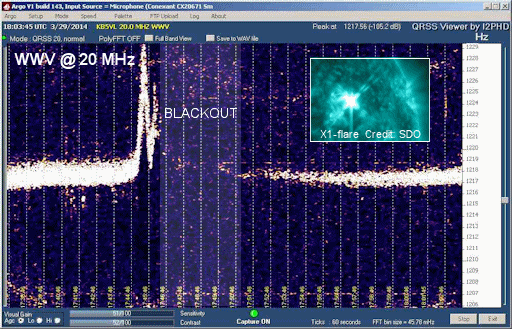
The Doppler shift of the WWV signal (the 'wobble' just before the blackout) was nearly 12 Hz, the most I have ever seen," says Nelson.
The flare not only blacked out radio signals, but also produced some radio signals of its own. The explosion above sunspot AR2017 sent shock waves racing through the sun's atmosphere at speeds as high as 4800 km/s (11 million mph). Radio emissions stimulated by those shocks crossed the 93 million mile divide to Earth, causing shortwave radio receivers to roar with static. Here is a plot of the outburstdetected by Nelson using a 20.1 MHz RadioJove receiver. Elsewhere, strong bursts were recorded at frequencies as high as 2800 MHz. It was a very broad band event.
Potentially Hazardous Asteroids (PHAs) are space rocks larger than approximately 100m that can come closer to Earth than 0.05 AU. None of the known PHAs is on a collision course with our planet, although astronomers are finding new ones all the time.
| Asteroid |
Date(UT)
|
Miss Distance
|
Size
|
| 2003 QQ47 |
Mar 26
|
49.9 LD
|
1.4 km
|
| 2014 FO38 |
Mar 29
|
4.8 LD
|
26 m
|
| 2014 FT37 |
Mar 29
|
1 LD
|
13 m
|
| 2014 FB44 |
Mar 31
|
8.9 LD
|
34 m
|
| 2014 FK38 |
Mar 31
|
3 LD
|
39 m
|
| 1995 SA |
Apr 2
|
73.1 LD
|
1.6 km
|
| 2000 HD24 |
Apr 4
|
42.2 LD
|
1.3 km
|
| 2007 HB15 |
Apr 28
|
6.7 LD
|
12 m
|
| 2010 JO33 |
May 17
|
4 LD
|
43 m
|
| 2005 UK1 |
May 20
|
36.7 LD
|
1.1 km
|
| 1997 WS22 |
May 21
|
47.1 LD
|
1.5 km
|
| 2002 JC |
May 24
|
48.7 LD
|
1.4 km
|